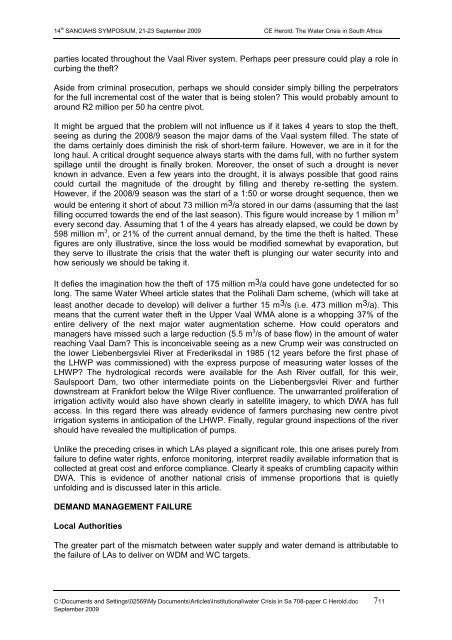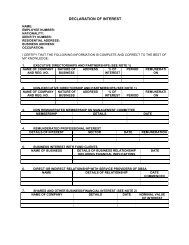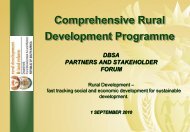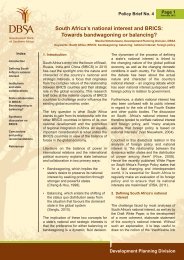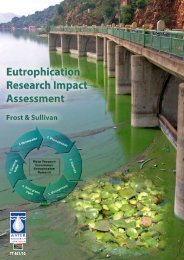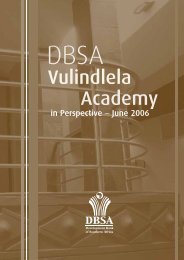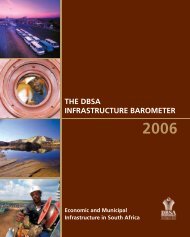The water Crisis in South Africa.pdf
The water Crisis in South Africa.pdf
The water Crisis in South Africa.pdf
You also want an ePaper? Increase the reach of your titles
YUMPU automatically turns print PDFs into web optimized ePapers that Google loves.
14 th SANCIAHS SYMPOSIUM, 21-23 September 2009 CE Herold: <strong>The</strong> Water <strong>Crisis</strong> <strong>in</strong> <strong>South</strong> <strong>Africa</strong>parties located throughout the Vaal River system. Perhaps peer pressure could play a role <strong>in</strong>curb<strong>in</strong>g the theft?Aside from crim<strong>in</strong>al prosecution, perhaps we should consider simply bill<strong>in</strong>g the perpetratorsfor the full <strong>in</strong>cremental cost of the <strong>water</strong> that is be<strong>in</strong>g stolen? This would probably amount toaround R2 million per 50 ha centre pivot.It might be argued that the problem will not <strong>in</strong>fluence us if it takes 4 years to stop the theft,see<strong>in</strong>g as dur<strong>in</strong>g the 2008/9 season the major dams of the Vaal system filled. <strong>The</strong> state ofthe dams certa<strong>in</strong>ly does dim<strong>in</strong>ish the risk of short-term failure. However, we are <strong>in</strong> it for thelong haul. A critical drought sequence always starts with the dams full, with no further systemspillage until the drought is f<strong>in</strong>ally broken. Moreover, the onset of such a drought is neverknown <strong>in</strong> advance. Even a few years <strong>in</strong>to the drought, it is always possible that good ra<strong>in</strong>scould curtail the magnitude of the drought by fill<strong>in</strong>g and thereby re-sett<strong>in</strong>g the system.However, if the 2008/9 season was the start of a 1:50 or worse drought sequence, then wewould be enter<strong>in</strong>g it short of about 73 million m3/a stored <strong>in</strong> our dams (assum<strong>in</strong>g that the lastfill<strong>in</strong>g occurred towards the end of the last season). This figure would <strong>in</strong>crease by 1 million m 3every second day. Assum<strong>in</strong>g that 1 of the 4 years has already elapsed, we could be down by598 million m 3 , or 21% of the current annual demand, by the time the theft is halted. <strong>The</strong>sefigures are only illustrative, s<strong>in</strong>ce the loss would be modified somewhat by evaporation, butthey serve to illustrate the crisis that the <strong>water</strong> theft is plung<strong>in</strong>g our <strong>water</strong> security <strong>in</strong>to andhow seriously we should be tak<strong>in</strong>g it.It defies the imag<strong>in</strong>ation how the theft of 175 million m3/a could have gone undetected for solong. <strong>The</strong> same Water Wheel article states that the Polihali Dam scheme, (which will take atleast another decade to develop) will deliver a further 15 m3/s (i.e. 473 million m3/a). Thismeans that the current <strong>water</strong> theft <strong>in</strong> the Upper Vaal WMA alone is a whopp<strong>in</strong>g 37% of theentire delivery of the next major <strong>water</strong> augmentation scheme. How could operators andmanagers have missed such a large reduction (5.5 m 3 /s of base flow) <strong>in</strong> the amount of <strong>water</strong>reach<strong>in</strong>g Vaal Dam? This is <strong>in</strong>conceivable see<strong>in</strong>g as a new Crump weir was constructed onthe lower Liebenbergsvlei River at Frederiksdal <strong>in</strong> 1985 (12 years before the first phase ofthe LHWP was commissioned) with the express purpose of measur<strong>in</strong>g <strong>water</strong> losses of theLHWP? <strong>The</strong> hydrological records were available for the Ash River outfall, for this weir,Saulspoort Dam, two other <strong>in</strong>termediate po<strong>in</strong>ts on the Liebenbergsvlei River and furtherdownstream at Frankfort below the Wilge River confluence. <strong>The</strong> unwarranted proliferation ofirrigation activity would also have shown clearly <strong>in</strong> satellite imagery, to which DWA has fullaccess. In this regard there was already evidence of farmers purchas<strong>in</strong>g new centre pivotirrigation systems <strong>in</strong> anticipation of the LHWP. F<strong>in</strong>ally, regular ground <strong>in</strong>spections of the rivershould have revealed the multiplication of pumps.Unlike the preced<strong>in</strong>g crises <strong>in</strong> which LAs played a significant role, this one arises purely fromfailure to def<strong>in</strong>e <strong>water</strong> rights, enforce monitor<strong>in</strong>g, <strong>in</strong>terpret readily available <strong>in</strong>formation that iscollected at great cost and enforce compliance. Clearly it speaks of crumbl<strong>in</strong>g capacity with<strong>in</strong>DWA. This is evidence of another national crisis of immense proportions that is quietlyunfold<strong>in</strong>g and is discussed later <strong>in</strong> this article.DEMAND MANAGEMENT FAILURELocal Authorities<strong>The</strong> greater part of the mismatch between <strong>water</strong> supply and <strong>water</strong> demand is attributable tothe failure of LAs to deliver on WDM and WC targets.C:\Documents and Sett<strong>in</strong>gs\02569\My Documents\Articles\Institutional\<strong>water</strong> <strong>Crisis</strong> <strong>in</strong> Sa 708-paper C Herold.doc 711September 2009


